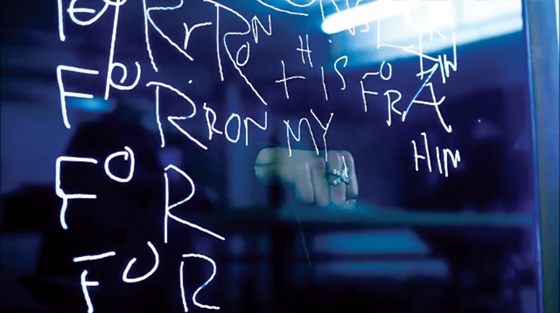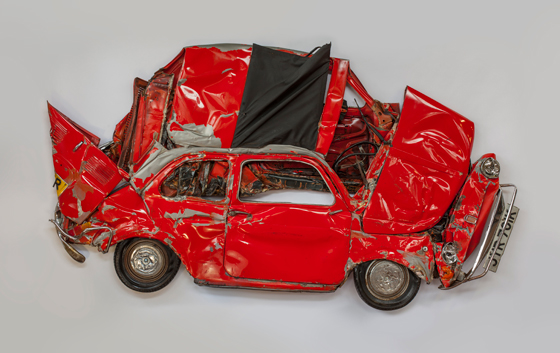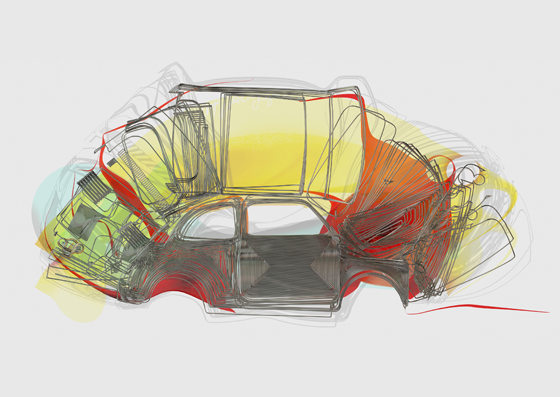Ron Arad – Deconstructed / reconstructed
Text von Jean-Philippe Peynot
12.02.14
Diese Seite wurde archiviert und wird nicht mehr aktualisiert
For over thirty years, Ron Arad has been producing unique objects that define a practise that falls somewhere between architecture, sculpture and design. If, in these creative fields, the longstanding question about whether form should follow function is still rife, the starting point for Ron Arad’s creations is often an object that has been taken out of its functional context and transformed. An original approach that still raises debate. TEXT BY JEAN-PHILIPPE PEYNOT
Ron Arad in front of an etching that appears to depict several mysterious Mobius strips. Last Train, 2013 © Ron Arad
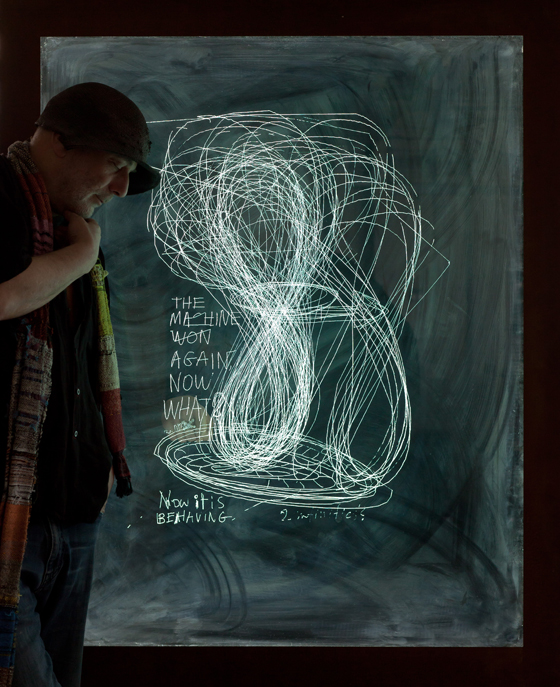
Ron Arad in front of an etching that appears to depict several mysterious Mobius strips. Last Train, 2013 © Ron Arad
×Jean-Philippe Peynot: Last Train, the exhibition currently showing at the 55th edition of the Venice Biennale, at the initiative of Steinmetz Diamonds, features glass panes, onto which you and invited artists, including Javier Mariscal and David Shrigley, scratched messages with a diamond mounted ring. The artists worked on a small digital screen [tablet], and the information was relayed to a machine that, in the manner of a printer, moved a replica of your hand bearing the ring that engraves the glass. Why such a complex system?
Ron Arad: The way you describe it seems complex, but it’s really very simple. The technology that enables us to see each other now [Skype], is more complicated. The end result is not printed by the Wi-Fi system or by the computer application. At the end of the day, its the movement of the hand and the ring that scratches the glass, while you see the drawing appear on the other side of the page. When I got everything working smoothly it was time to invite some of my friends and colleagues to partake in the experience. And the nice thing is that everybody took a different approach to it. Some came and practiced for a long time before they were ready. Others came with an idea that they had quickly come up with. And everyone enjoyed it.
J-P.P: There is a very strong contrast between the diamond, which once cut becomes the symbol of luxury and beauty, and the scratched glass, which is reminiscent of public transport, and the most trivial moments in everyday life. Was this contrast the starting point of this project? And why didn’t you exhibit the diamonds?
R.A.: There is also a contrast between the mark of a pencil and a white page. That’s what makes the drawing come alive: the contrast between the mark and what is being marked. I am not so excited about the value of diamonds. But there is something fascinating about the material itself, how it was formed, its history and also its strength. If you attempt to scratch a diamond with glass it’s impossible, but you will see a scratch on the glass. There is also something about the quality of a scratched line on glass. When I was asked to work on a project with diamonds I didn’t see myself doing earrings. But I designed the ring [laughs].
The amazing machine invented by Ron Arad for etching glass. Last Train, 2013 © Ron Arad
In Reverse, exhibition view, with the famous Rover chair and Aerial lamp, both designed in 1981. 2013 © Ron Arad

In Reverse, exhibition view, with the famous Rover chair and Aerial lamp, both designed in 1981. 2013 © Ron Arad
×J-P.P: There is something a little Dada-esque about this machine. The way the diamond is "reinterpreted", diverted from its main function, which calls to mind Duchamp, his machinery and of course his famous Grand Verre. Did you have Duchamp in mind when you conceived this project?
R.A.: I often think of Duchamp and the Large Glass is there, whether you like it or not, but, for this project, I immediately thought about Queen Elisabeth I, before thinking of Duchamp. I also thought about Robert Burns, who scratched some of his poems on glass, and lots of people associated with graffiti. If you take the tube in London, there are so many messages of love and hate scratched on the glass that you can’t see through the window. All I did is shed a little light on something that exists.
J-P.P: Franz West, Bertrand Lavier, Tobias Rehberger... many artists continue to question the status of objects following in the footsteps of Duchamp. This is a dimension that seems to be present in your work, but do you think other designers understood Duchamp? Isn’t this questioning of the status of the object the main difference between artists and designers nowadays?
R.A.: Everyone is the sum of their own references. The place they grew up, the era, the environment… When I grew up as an artist, Duchamp was undoubtably a hero, but I recently discovered that I am more interested in Man Ray. Maybe he deserves more limelight. People talk a lot about the cross-over between design and art, and that’s a waste of time for me. I am not interested in breaking down barriers. You don’t need a passport to go from one discipline to another. I found myself in the design world by accident. My first piece [the Rover chair] was ready-made “a found object” that I connected more to Duchamp than to Prouvé. Yet this chair is very much in the style of Prouvé, and to a certain extent, I was pushed into design.
J-P.P: You currently have another exhibition entitled In Reverse at the Holon Design Museum. You were the architect that designed this museum. What is the purpose of the exhibition? Is it a way to unite architecture, art and design in a single project: your own?
R.A.: No, there were two objectives: the first was to ensure that myself and my team enjoyed creating the exhibition. The second was to create something that visitors would enjoy. And both these objectives were met. Yes it happenend in a museum that we designed, and that allowed us to relax, to flex our muscles, because otherwise, we know that the museum is always the winner.
In the foreground: Roddy Giacosa (2013), a sculpture that necessitated the implication of a computer and artisan, facing a ready-made mould of a 1956 Fiat 500, caught up in a game of representations. 2013 © Ron Arad
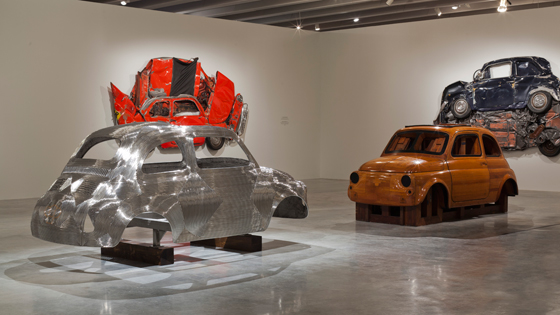
In the foreground: Roddy Giacosa (2013), a sculpture that necessitated the implication of a computer and artisan, facing a ready-made mould of a 1956 Fiat 500, caught up in a game of representations. 2013 © Ron Arad
×J-P.P: Six Fiat 500s, each flattened and hung on a wall, are the highlight of the exhibition. It’s difficult to look at a crushed and exposed car without thinking of artists like John Chamberlain or César, but here the work seems immediately very different. The cars are not sculptural in appearance, they’re almost like drawings. It’s as if you wanted to turn them into signs. Should we see it as an experimental work? Semantic research?
R.A: Yes, the objective is different. With In reverse, we took functional, three- dimensional objects, and then transformed them into non-functional, two-dimensional objects. It reminds some people of Disney because when they look at the cars they appear to be squashed flat against the wall. The six crushed cars are exactly the same, but they come from different places. Even if they shared the same fate, each one has a very different character and evokes something completely different. Also the show is about the shift away from manual labour, from physical to digital objects. We made a computer generated film about it. It shows a car being crushed, and then it comes to life, and is crushed again. And at the center of the exhibition, there is a piece which is a symbiosis between the two: Roddy Giacosa, that necessitated the implication of a computer and the artisan.
J-P.P: As in Venice, the technology is there and we go from the object to its representation, using sophisticated printing techniques, to enhance the crushing process. You seem to destroy to rebuild, draw then produce, going back and forth from the object to its representation. Is this your way of working? The secret of your creations?
R.A: Yes, that’s what I do. I’m used to drawing things that don’t exist, and as a consequence representation comes before the object. So in a way, the object finally becomes the representation of my representation. But here there is something else: it looks like the representation of the car, but it is the car. The car representing itself… Maybe I should call Lacan.
J-P.P: If you contact Lacan, Skype would be a better option than the phone! You have had many solo exhibitions all over the world, including MoMA New York and the Pompidou Centre in Paris. You always get very involved, down to the smallest details of the scenography. How important are these shows to your work?
R.A: It’s very important. The last show kept us busy for nine months. It was the big event, more important than all the other stuff that we do. There wasn’t a dull moment. The aim, for this show, as always, is to create delight.
Roddy Giacosa (2013), sculpture designed with the aid of a computer and made by artisans. © Ron Arad
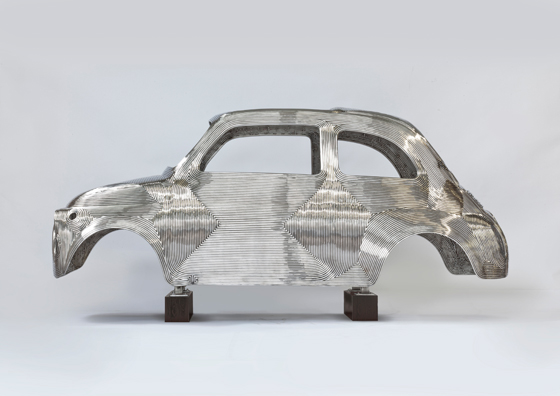
Roddy Giacosa (2013), sculpture designed with the aid of a computer and made by artisans. © Ron Arad
×In Reverse, exhibition view of the ready-made mould of a 1956 Fiat 500, caught up in a game of representations 2013 © Ron Arad
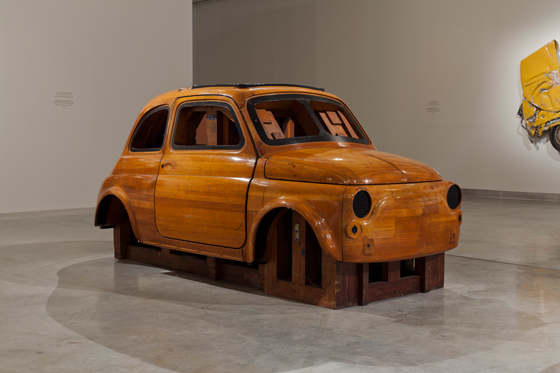
In Reverse, exhibition view of the ready-made mould of a 1956 Fiat 500, caught up in a game of representations 2013 © Ron Arad
×J-P.P: In your "indiscipline", which allows you to play with design, as well as art and architecture without respecting the rules, and in your application, that one might deem similar to “deconstruction” a theory developed by Derrida and practised by architects like Bernard Tschumi, there is a specificity that is beyond all these categories, and the word that comes to my mind is: “punk”. Could we take the liberty of qualifying you as a “punk designer”, or more precisely “post-punk designer?”
R.A: I was tempted many years ago, when I worked with pieces of broken concrete, but I think it would be a false pretence because I am “very spoiled”, also culturally. But you’re right, I have no respect for conventions and yes, there are similarities between my lack of respect for conventions and punk ideology. One could argue that it is because I am not very good with conventional things. I am probably not a good player on a normal ping-pong table, but I am very good on my own table. So maybe there is a lesson there. Interpret what you will.
J-P.P: In the diversity of your work, there is a form that seems to come around more often than others: the strip, or rather the Mobius strip. It is present in numerous pieces (D sofa, 1994, Evergreen, 2003, Oh Void, 2006), and even in the architecture of the museum which held this retrospective of your work. Why does this form inspire you so much?
R. A: You can work with dots or lines, and I work with both of them. Line is maybe more natural because my best tool is a pencil. Every time I start drawing, strips appear, but I don’t have a contract with strips. It’s like the question: what is your favourite colour? I don’t have a favorite colour. All colours, lines and shapes are valid. Usually people talk about curves, but you’re the first one to ask about strips. The Mobius strips are fantastic. Do you know what happens if you cut one in half? There aren’t two pieces, you’re left with one even bigger strip. I have never really incorporated a Mobius strip in my work, but I could try it.

